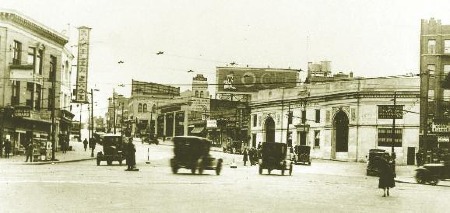 Fordham is geographically located in the west Bronx. The neighborhood is part of Bronx Community Board 5. Its boundaries, starting from the north and moving clockwise are: Fordham Road to the north, Webster Avenue to the east, East 183rd Street to the south, and Jerome Avenue to the west. The Grand Concourse is the primary thoroughfare through Fordham. The main subway through the area is the D line, operating along the Grand Concourse, with the Jerome Avenue line on its western border. Zip codes include 10453, 10457, 10458 and 10468. The area is patrolled by the 46th Precinct located at 2120 Ryer Avenue. NYCHA property in the area is patrolled by P.S.A. 7 at 737 Melrose Avenue in the Melrose section of the Bronx.
Fordham is geographically located in the west Bronx. The neighborhood is part of Bronx Community Board 5. Its boundaries, starting from the north and moving clockwise are: Fordham Road to the north, Webster Avenue to the east, East 183rd Street to the south, and Jerome Avenue to the west. The Grand Concourse is the primary thoroughfare through Fordham. The main subway through the area is the D line, operating along the Grand Concourse, with the Jerome Avenue line on its western border. Zip codes include 10453, 10457, 10458 and 10468. The area is patrolled by the 46th Precinct located at 2120 Ryer Avenue. NYCHA property in the area is patrolled by P.S.A. 7 at 737 Melrose Avenue in the Melrose section of the Bronx.
Fordham has a population of 77,840 people. Its first growth was in the 1930s, when middle-class and working-class families from Manhattan flocked into the area, attracted by the then-modern housing and convenient subway access by Concourse and Jerome Avenue lines to business districts in Manhattan where they could work and shop. The demographics are 31.3% White, 23.2% African American, 1.3% Native American, 4.7% Asian, 0.1% Pacific Islander, 31.6% other, 7.8% two or more races and 58.8% Hispanic or Latino.
The Fordham name, in the Bronx, has its beginnings in 1671 when Governor Lovelace gave a Manor grant to Dutchman John Arcer. John established Fordham Manor which stretched from the Harlem River (on the west) to the Bronx River (on the east) and from High Bridge (on the south) to Spuyten Duyvil (on the north). During this time, the only direct passage to the Bronx from Manhattan was a shallow crossing through the Harlem River. A small number of Dutch families that were originally living in the Harlem area settled around this crossing in Fordham Manor. The name Fordham has its origins from this crossing and settlement – the words “ford” and “ham,” meaning houses by the shallow area or a wading place.
The Fordham area and Fordham Road we know today stems from the Fordham Manor, but it has its closest ties with a rural village (Fordham Village) that developed around the New York Central Railroad station of Fordham (on Webster Avenue and Fordham Road) and St. John’s College (now Fordham University). Before the 1900’s, like much of the Bronx at that time, the Fordham Village was composed of small farms and estates. In 1845, this rural atmosphere attracted the renowned writer Edgar Allan Poe to move into a cottage in Fordham Village where he wrote “Annabel Lee” and “The Bells.” The Fordham community continued to gain popularity with the opening of the New York Botanical Gardens in 1891.
During the early 1900’s, the emergence of inexpensive and accessible rapid transit like the Third Avenue El, the Jerome Avenue IRT, and the IND under the Grand Concourse drew a large influx of people to Fordham from Manhattan and the lower Bronx. With the sprouting, multicultural population came more neighborhood stores and larger businesses to serve the booming community. This included the construction of the $4 million Loew’s Paradise Theater in 1929 and the opening of an Alexander’s department store in 1938. Fordham Road went on to replace 149th Street (the Hub) as the Bronx’s prominent shopping and entertainment center.
Fordham was a predominantly middle class Jewish neighborhood, from the 1930s through the 1970s, when many Jewish families moved to the suburbs or retired to Florida.
After a wave of arson ravaged the low income communities of New York City throughout the 1970s, many of the residential structures in Fordham were left seriously damaged or destroyed. The city began to rehabilitate many formerly abandoned tenement style apartment buildings and designate them low income housing beginning in the late 1970s. Also many subsidized attached multi-unit townhouses and newly constructed apartment buildings have been or are being built on vacant lots across across the neighborhood.
Today, Fordham Road’s successful mixture of small independent shops and national and regional chain stores has kept it as the largest and most prominent shopping district in the Bronx and one of the largest in New York City. Fordham is nowa bustling, vibrant community.
